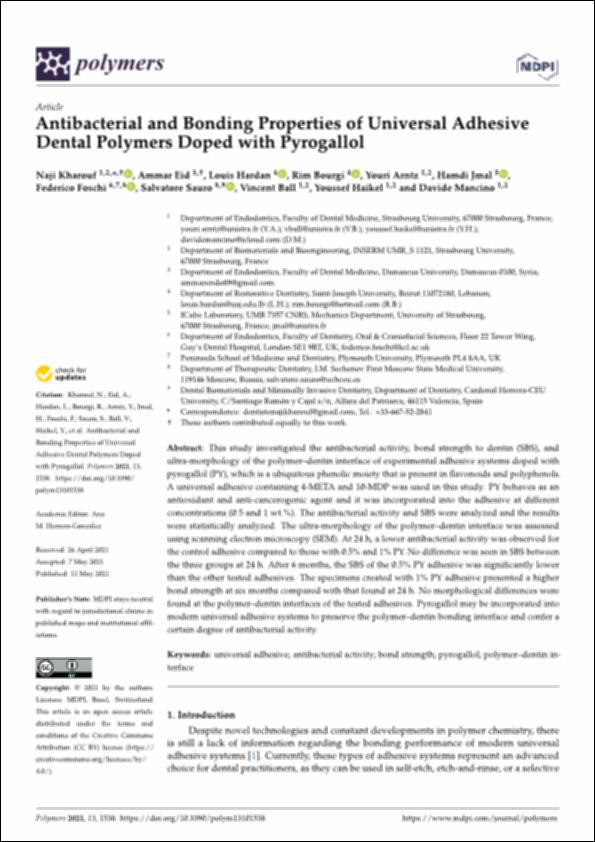Please use this identifier to cite or link to this item:
http://hdl.handle.net/10637/13575Antibacterial and bonding properties of universal adhesive dental polymers doped with Pyrogallol
| Title: | Antibacterial and bonding properties of universal adhesive dental polymers doped with Pyrogallol |
| Authors : | Kharouf, Naji Eid, Ammar Hardan, Louis Bourgi, Rim Arntz, Youri Jmal, Hamdi Sauro, Salvatore. |
| Keywords: | Pyrogallol in Dentistry.; Polymers in Dentistry.; Dentina.; Pirogalol - Aplicaciones en Odontología.; Adhesivos dentales.; Dental adhesives.; Polímeros - Aplicaciones en Odontología.; Dentin. |
| Publisher: | MDPI |
| Citation: | Kharouf, N., Eid, A., Hardan, L., Bourgi, R., Arntz, Y., Jmal, H., Foschi, F., Sauro, S., Ball, V., Haikel, Y. & Mancino, D. (2021). Antibacterial and bonding properties of universal adhesive dental polymers doped with Pyrogallol. Polymers, vol. 13, i. 10 (11 may.), art. 1538. DOI: https://doi.org/10.3390/polym13101538 |
| Abstract: | This study investigated the antibacterial activity, bond strength to dentin (SBS), and ultra-morphology of the polymer–dentin interface of experimental adhesive systems doped with pyrogallol (PY), which is a ubiquitous phenolic moiety that is present in flavonoids and polyphenols. A universal adhesive containing 4-META and 10-MDP was used in this study. PY behaves as an antioxidant and anti-cancerogenic agent and it was incorporated into the adhesive at different concentrations (0.5 and 1 wt.%). The antibacterial activity and SBS were analyzed and the results were statistically analyzed. The ultra-morphology of the polymer–dentin interface was assessed using scanning electron microscopy (SEM). At 24 h, a lower antibacterial activity was observed for the control adhesive compared to those with 0.5% and 1% PY. No difference was seen in SBS between the three groups at 24 h. After 6 months, the SBS of the 0.5% PY adhesive was significantly lower than the other tested adhesives. The specimens created with 1% PY adhesive presented a higher bond strength at six months compared with that found at 24 h. No morphological differences were found at the polymer–dentin interfaces of the tested adhesives. Pyrogallol may be incorporated into modern universal adhesive systems to preserve the polymer–dentin bonding interface and confer a certain degree of antibacterial activity. |
| Description: | Este artículo se encuentra disponible en la siguiente URL: https://www.mdpi.com/2073-4360/13/10/1538 En este artículo de investigación también participan: Federico Foschi, Vincent Ball, Youssef Haikel y Davide Mancino. Este artículo de investigación pertenece al número especial "Design of Monomers and Polymers with Dental Applications: Dental Composites and Adhesives". |
| URI: | http://hdl.handle.net/10637/13575 |
| Rights : | http://creativecommons.org/licenses/by/4.0/deed.es |
| ISSN: | 2073-4360 (Electrónico) |
| Issue Date: | 11-May-2021 |
| Center : | Universidad Cardenal Herrera-CEU |
| Appears in Collections: | Dpto. Odontología |
Items in DSpace are protected by copyright, with all rights reserved, unless otherwise indicated.


